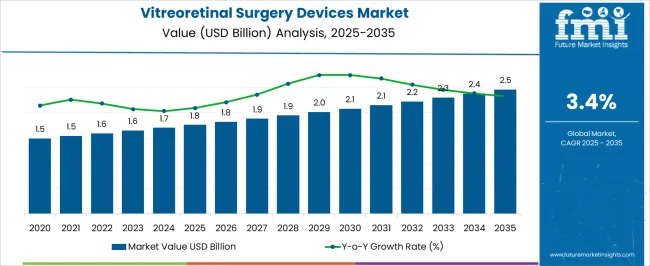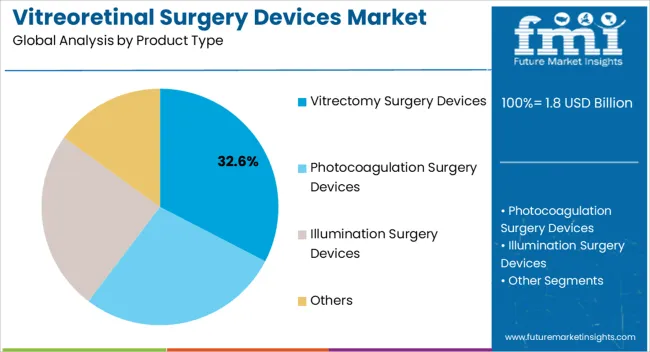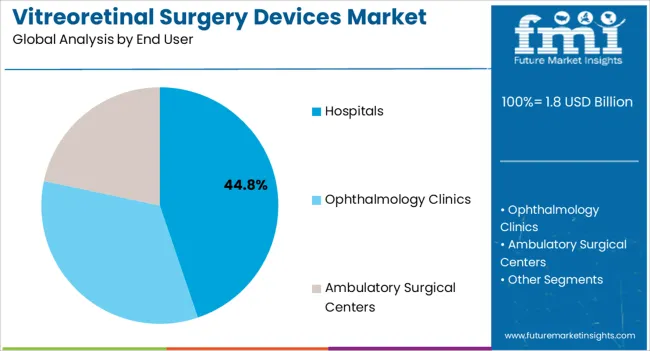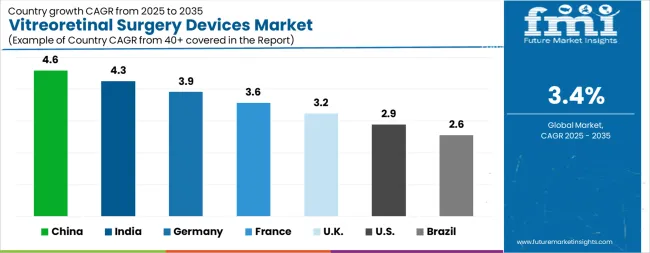The Vitreoretinal Surgery Devices Market is estimated to be valued at USD 1.8 billion in 2025 and is projected to reach USD 2.5 billion by 2035, registering a compound annual growth rate (CAGR) of 3.4% over the forecast period.

| Metric | Value |
|---|---|
| Vitreoretinal Surgery Devices Market Estimated Value in (2025 E) | USD 1.8 billion |
| Vitreoretinal Surgery Devices Market Forecast Value in (2035 F) | USD 2.5 billion |
| Forecast CAGR (2025 to 2035) | 3.4% |
The Vitreoretinal Surgery Devices market is experiencing steady growth, driven by the increasing prevalence of retinal disorders and ocular diseases requiring advanced surgical interventions. Rising incidences of diabetic retinopathy, retinal detachment, macular degeneration, and other vitreoretinal conditions are fueling demand for specialized surgical devices. Technological advancements, including high-precision vitrectomy tools, micro-incision instruments, and integrated imaging systems, are enhancing surgical outcomes and procedural efficiency.
Hospitals and specialized ophthalmic centers are increasingly adopting these devices to ensure improved patient recovery and reduced operative complications. The market is further supported by growing awareness among ophthalmologists and patients regarding early diagnosis and advanced treatment options. Investments in research and development have enabled improvements in device safety, ergonomics, and usability, driving clinical adoption.
Regulatory support for minimally invasive and high-precision surgical solutions is also encouraging market expansion As the aging population grows and healthcare infrastructure improves globally, the demand for vitreoretinal surgery devices is expected to continue rising, offering significant growth potential in both developed and emerging markets.
The vitreoretinal surgery devices market is segmented by product type, end user, and geographic regions. By product type, vitreoretinal surgery devices market is divided into Vitrectomy Surgery Devices, Photocoagulation Surgery Devices, Illumination Surgery Devices, and Others. In terms of end user, vitreoretinal surgery devices market is classified into Hospitals, Ophthalmology Clinics, and Ambulatory Surgical Centers. Regionally, the vitreoretinal surgery devices industry is classified into North America, Latin America, Western Europe, Eastern Europe, Balkan & Baltic Countries, Russia & Belarus, Central Asia, East Asia, South Asia & Pacific, and the Middle East & Africa.

The vitrectomy surgery devices segment is projected to hold 32.6% of the market revenue in 2025, establishing it as the leading product type. Growth in this segment is being driven by the high demand for precise and minimally invasive surgical interventions in vitreoretinal procedures. Vitrectomy devices enable effective removal of vitreous humor, correction of retinal tears, and management of other complex ocular conditions, thereby improving patient outcomes.
The development of micro-incision and high-speed cutting technologies has enhanced procedural efficiency and reduced recovery time, further strengthening adoption. Compatibility with advanced imaging systems and integration with surgical microscopes have increased precision, allowing surgeons to perform complex procedures with improved control. Rising prevalence of diabetic retinopathy, retinal detachment, and macular disorders is reinforcing demand.
Hospitals and specialized ophthalmology centers are prioritizing the acquisition of high-performance vitrectomy devices to improve surgical success rates and patient satisfaction Continuous innovation in device safety, ergonomics, and operational efficiency is expected to maintain the leading position of this product type in the market.

The hospitals end user segment is anticipated to account for 44.8% of the market revenue in 2025, making it the largest end-use category. Growth in this segment is being driven by the concentration of vitreoretinal surgical procedures in hospital settings due to the availability of specialized infrastructure, skilled ophthalmologists, and advanced imaging and operative equipment. Hospitals are increasingly investing in high-precision surgical devices to provide improved patient outcomes, reduce post-operative complications, and enhance operational efficiency.
The ability to perform complex vitreoretinal surgeries with integrated imaging, micro-incision instruments, and vitrectomy systems has reinforced adoption in these facilities. Furthermore, regulatory requirements, patient safety considerations, and quality standards encourage hospitals to prioritize certified and technologically advanced surgical devices.
The growing demand for ophthalmic care, coupled with the expansion of hospital networks and enhanced healthcare accessibility in both developed and emerging regions, continues to support this segment As hospitals increasingly serve as primary centers for vitreoretinal interventions, their reliance on advanced surgical devices is expected to sustain and drive market growth.
Vitreoretinal surgery is a surgery of the eye for treatment of complication related to retina, vitreous fluid and macula. Vitreoretinal surgery procedures commonly include retinal tears, diabetic retinopathy, retinal detachments, ocular trauma, macular degeneration, ocular tumor treatment and hereditary retinal disease treatment.
Eye is a very delicate organ and performing an eye surgery requires precision for which doctors use various assistive devices while performing vitreoretinal surgeries. Vitreoretinal surgery devices

| Country | CAGR |
|---|---|
| China | 4.6% |
| India | 4.3% |
| Germany | 3.9% |
| France | 3.6% |
| UK | 3.2% |
| USA | 2.9% |
| Brazil | 2.6% |
The Vitreoretinal Surgery Devices Market is expected to register a CAGR of 3.4% during the forecast period, exhibiting varied country level momentum. China leads with the highest CAGR of 4.6%, followed by India at 4.3%. Developed markets such as Germany, France, and the UK continue to expand steadily, while the USA is likely to grow at consistent rates. Brazil posts the lowest CAGR at 2.6%, yet still underscores a broadly positive trajectory for the global Vitreoretinal Surgery Devices Market. In 2024, Germany held a dominant revenue in the Western Europe market and is expected to grow with a CAGR of 3.9%. The USA Vitreoretinal Surgery Devices Market is estimated to be valued at USD 617.9 million in 2025 and is anticipated to reach a valuation of USD 821.5 million by 2035. Sales are projected to rise at a CAGR of 2.9% over the forecast period between 2025 and 2035. While Japan and South Korea markets are estimated to be valued at USD 90.4 million and USD 55.7 million respectively in 2025.

| Item | Value |
|---|---|
| Quantitative Units | USD 1.8 Billion |
| Product Type | Vitrectomy Surgery Devices, Photocoagulation Surgery Devices, Illumination Surgery Devices, and Others |
| End User | Hospitals, Ophthalmology Clinics, and Ambulatory Surgical Centers |
| Regions Covered | North America, Europe, Asia-Pacific, Latin America, Middle East & Africa |
| Country Covered | United States, Canada, Germany, France, United Kingdom, China, Japan, India, Brazil, South Africa |
| Key Companies Profiled | Alcon, Bausch + Lomb, BVI, Carl Zeiss Meditec, CooperVision, Designs for Vision, HOYA Surgical Optics, MedOne, OCULUS, Oertli, Peregrine Surgical, and STAAR SURGICAL |
The global vitreoretinal surgery devices market is estimated to be valued at USD 1.8 billion in 2025.
The market size for the vitreoretinal surgery devices market is projected to reach USD 2.5 billion by 2035.
The vitreoretinal surgery devices market is expected to grow at a 3.4% CAGR between 2025 and 2035.
The key product types in vitreoretinal surgery devices market are vitrectomy surgery devices, photocoagulation surgery devices, illumination surgery devices and others.
In terms of end user, hospitals segment to command 44.8% share in the vitreoretinal surgery devices market in 2025.






Our Research Products

The "Full Research Suite" delivers actionable market intel, deep dives on markets or technologies, so clients act faster, cut risk, and unlock growth.

The Leaderboard benchmarks and ranks top vendors, classifying them as Established Leaders, Leading Challengers, or Disruptors & Challengers.

Locates where complements amplify value and substitutes erode it, forecasting net impact by horizon

We deliver granular, decision-grade intel: market sizing, 5-year forecasts, pricing, adoption, usage, revenue, and operational KPIs—plus competitor tracking, regulation, and value chains—across 60 countries broadly.

Spot the shifts before they hit your P&L. We track inflection points, adoption curves, pricing moves, and ecosystem plays to show where demand is heading, why it is changing, and what to do next across high-growth markets and disruptive tech

Real-time reads of user behavior. We track shifting priorities, perceptions of today’s and next-gen services, and provider experience, then pace how fast tech moves from trial to adoption, blending buyer, consumer, and channel inputs with social signals (#WhySwitch, #UX).

Partner with our analyst team to build a custom report designed around your business priorities. From analysing market trends to assessing competitors or crafting bespoke datasets, we tailor insights to your needs.
Supplier Intelligence
Discovery & Profiling
Capacity & Footprint
Performance & Risk
Compliance & Governance
Commercial Readiness
Who Supplies Whom
Scorecards & Shortlists
Playbooks & Docs
Category Intelligence
Definition & Scope
Demand & Use Cases
Cost Drivers
Market Structure
Supply Chain Map
Trade & Policy
Operating Norms
Deliverables
Buyer Intelligence
Account Basics
Spend & Scope
Procurement Model
Vendor Requirements
Terms & Policies
Entry Strategy
Pain Points & Triggers
Outputs
Pricing Analysis
Benchmarks
Trends
Should-Cost
Indexation
Landed Cost
Commercial Terms
Deliverables
Brand Analysis
Positioning & Value Prop
Share & Presence
Customer Evidence
Go-to-Market
Digital & Reputation
Compliance & Trust
KPIs & Gaps
Outputs
Full Research Suite comprises of:
Market outlook & trends analysis
Interviews & case studies
Strategic recommendations
Vendor profiles & capabilities analysis
5-year forecasts
8 regions and 60+ country-level data splits
Market segment data splits
12 months of continuous data updates
DELIVERED AS:
PDF EXCEL ONLINE
Biosurgery Equipment Market Size and Share Forecast Outlook 2025 to 2035
Post-Surgery Skin Repair Market Analysis - Size and Share Forecast Outlook 2025 to 2035
Neurosurgery Surgical Power Tools Market Analysis – Growth & Forecast 2022-2032
Electrosurgery Accessories Market Size and Share Forecast Outlook 2025 to 2035
Guided Surgery Kits Market Size, Growth, and Forecast for 2025 to 2035
Electrosurgery Generators Market Analysis - Size, Share, and Forecast 2025 to 2035
Electrosurgery Devices Market Overview - Trends & Growth Forecast 2025 to 2035
General Surgery Devices Market Insights – Demand and Growth Forecast 2025 to 2035
Cardiac Surgery Devices Market Analysis – Trends & Forecast 2024-2034
Cosmetic Surgery Products Market Analysis - Size, Share, and Forecast Outlook 2025 to 2035
Cataract Surgery Device Market Analysis – Growth & Forecast 2024-2034
Bariatric Surgery Device Market Forecast and Outlook 2025 to 2035
5G Remote Surgery System Market Analysis - Size, Share, and Forecast Outlook 2025 to 2035
Refractive Surgery Device Market Size and Share Forecast Outlook 2025 to 2035
Lung Cancer Surgery Market - Size, Share, and Forecast 2025 to 2035
Dental Flap Surgery Market Size and Share Forecast Outlook 2025 to 2035
Dental Microsurgery Market Overview - Trends & Forecast 2024 to 2034
The Liposuction Surgery Devices Market is segmented By Technology and End User from 2025 to 2035
Stereotactic Surgery Devices Market Insights by Product, Application, and Region through 2035
Mixed Reality Surgery Market Analysis - Size and Share Forecast Outlook 2025 to 2035

Thank you!
You will receive an email from our Business Development Manager. Please be sure to check your SPAM/JUNK folder too.
Chat With
MaRIA